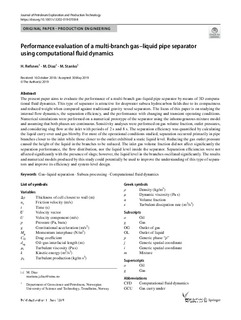| dc.contributor.author | Refsnes, Helene Sund | |
| dc.contributor.author | Diaz, Mariana J.C. | |
| dc.contributor.author | Stanko, Milan | |
| dc.date.accessioned | 2019-06-17T06:24:06Z | |
| dc.date.available | 2019-06-17T06:24:06Z | |
| dc.date.created | 2019-06-13T18:14:18Z | |
| dc.date.issued | 2019 | |
| dc.identifier.citation | Journal of Petroleum Exploration and Production Technology. 2019 | nb_NO |
| dc.identifier.issn | 2190-0558 | |
| dc.identifier.uri | http://hdl.handle.net/11250/2600916 | |
| dc.description.abstract | The present paper aims to evaluate the performance of a multi-branch gas–liquid pipe separator by means of 3D computational fluid dynamics. This type of separator is attractive for deepwater subsea hydrocarbon fields due to its compactness and reduced weight when compared against traditional gravity vessel separators. The focus of this paper is on studying the internal flow dynamics, the separation efficiency, and the performance with changing and transient operating conditions. Numerical simulations were performed on a numerical prototype of the separator using the inhomogeneous mixture model and assuming that both phases are continuous. Sensitivity analyses were performed on gas volume fraction, outlet pressures, and considering slug flow at the inlet with periods of 2 s and 8 s. The separation efficiency was quantified by calculating the liquid carry-over and gas blowby. For most of the operational conditions studied, separation occurred primarily in pipe branches closer to the inlet while those closer to the outlet exhibited a static liquid level. Reducing the gas outlet pressure caused the height of the liquid in the branches to be reduced. The inlet gas volume fraction did not affect significantly the separation performance, the flow distribution, nor the liquid level inside the separator. Separation efficiencies were not affected significantly with the presence of slugs; however, the liquid level in the branches oscillated significantly. The results and numerical models produced by this study could potentially be used to improve the understanding of this type of separators and improve its efficiency and system-level design. | nb_NO |
| dc.language.iso | eng | nb_NO |
| dc.publisher | Springer | nb_NO |
| dc.rights | Navngivelse 4.0 Internasjonal | * |
| dc.rights.uri | http://creativecommons.org/licenses/by/4.0/deed.no | * |
| dc.title | Performance evaluation of a multi‑branch gas–liquid pipe separator using computational fluid dynamics | nb_NO |
| dc.type | Journal article | nb_NO |
| dc.type | Peer reviewed | nb_NO |
| dc.description.version | publishedVersion | nb_NO |
| dc.source.journal | Journal of Petroleum Exploration and Production Technology | nb_NO |
| dc.identifier.doi | https://doi.org/10.1007/s13202-019-0708-8 | |
| dc.identifier.cristin | 1704749 | |
| dc.description.localcode | © The Author(s) 2019 Open Access This article is distributed under the terms of the Creative Commons Attribution 4.0 International License (http://creativecommons.org/licenses/by/4.0/), which permits unrestricted use, distribution, and reproduction in any medium, provided you give appropriate credit to the original author(s) and the source, provide a link to the Creative Commons license, and indicate if changes were made. | nb_NO |
| cristin.unitcode | 194,64,90,0 | |
| cristin.unitname | Institutt for geovitenskap og petroleum | |
| cristin.ispublished | true | |
| cristin.fulltext | preprint | |
| cristin.qualitycode | 1 | |

